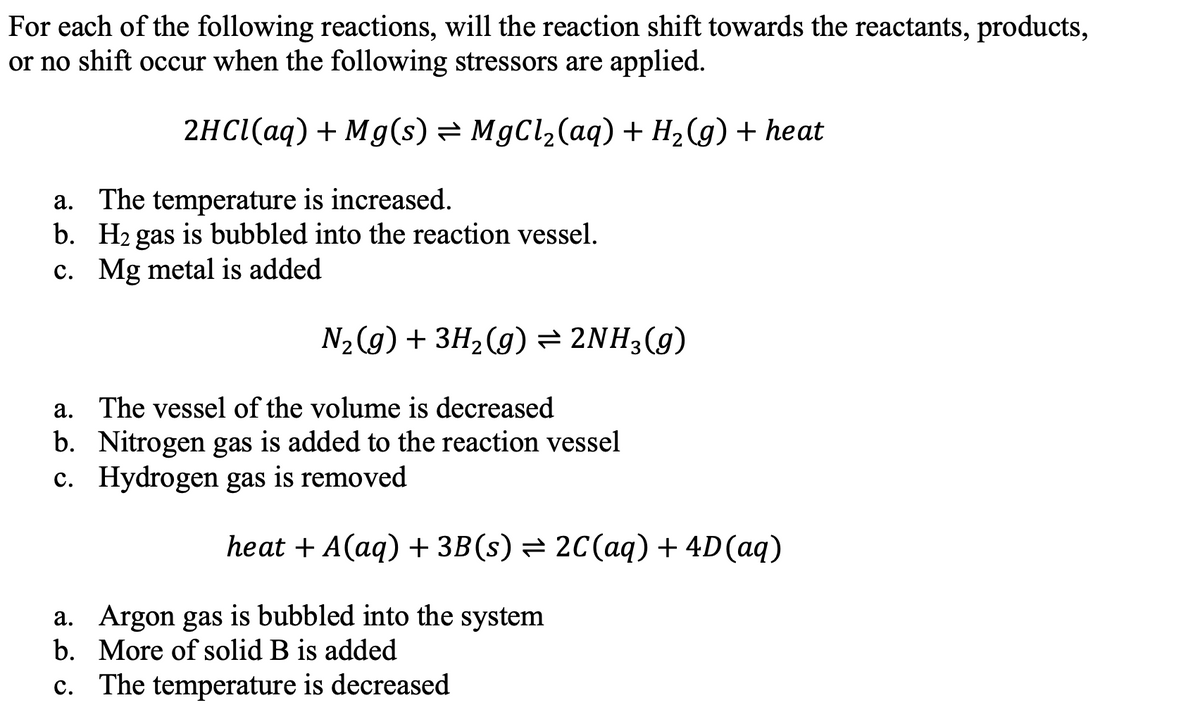For each of the following reactions, will the reaction shift towards the reactants, products, or no shift occur when the following stressors are applied. 2HCI(aq) + Mg(s) = MgCl,(aq) + H2(g) + heat a. The temperature is increased. b. H2 gas is bubbled into the reaction vessel. c. Mg metal is added
For each of the following reactions, will the reaction shift towards the reactants, products, or no shift occur when the following stressors are applied. 2HCI(aq) + Mg(s) = MgCl,(aq) + H2(g) + heat a. The temperature is increased. b. H2 gas is bubbled into the reaction vessel. c. Mg metal is added
Chemistry & Chemical Reactivity
9th Edition
ISBN:9781133949640
Author:John C. Kotz, Paul M. Treichel, John Townsend, David Treichel
Publisher:John C. Kotz, Paul M. Treichel, John Townsend, David Treichel
Chapter18: Principles Of Chemical Reactivity: Entropy And Free Energy
Section: Chapter Questions
Problem 67SCQ
Related questions
Question

Transcribed Image Text:For each of the following reactions, will the reaction shift towards the reactants, products,
or no shift occur when the following stressors are applied.
2HCI(aq) + Mg(s) = MgCl2(aq) + H2(g) + heat
a. The temperature is increased.
b. H2 gas is bubbled into the reaction vessel.
c. Mg metal is added
N2 (g) + 3H2(g) = 2NH3(g)
a. The vessel of the volume is decreased
b. Nitrogen gas is added to the reaction vessel
c. Hydrogen gas is removed
heat + A(aq) + 3B(s) = 2C(aq) + 4D(aq)
a. Argon gas is bubbled into the system
b. More of solid B is added
c. The temperature is decreased
Expert Solution
This question has been solved!
Explore an expertly crafted, step-by-step solution for a thorough understanding of key concepts.
This is a popular solution!
Trending now
This is a popular solution!
Step by step
Solved in 2 steps

Knowledge Booster
Learn more about
Need a deep-dive on the concept behind this application? Look no further. Learn more about this topic, chemistry and related others by exploring similar questions and additional content below.Recommended textbooks for you

Chemistry & Chemical Reactivity
Chemistry
ISBN:
9781133949640
Author:
John C. Kotz, Paul M. Treichel, John Townsend, David Treichel
Publisher:
Cengage Learning

Chemistry: Principles and Practice
Chemistry
ISBN:
9780534420123
Author:
Daniel L. Reger, Scott R. Goode, David W. Ball, Edward Mercer
Publisher:
Cengage Learning

Chemistry
Chemistry
ISBN:
9781305957404
Author:
Steven S. Zumdahl, Susan A. Zumdahl, Donald J. DeCoste
Publisher:
Cengage Learning

Chemistry & Chemical Reactivity
Chemistry
ISBN:
9781133949640
Author:
John C. Kotz, Paul M. Treichel, John Townsend, David Treichel
Publisher:
Cengage Learning

Chemistry: Principles and Practice
Chemistry
ISBN:
9780534420123
Author:
Daniel L. Reger, Scott R. Goode, David W. Ball, Edward Mercer
Publisher:
Cengage Learning

Chemistry
Chemistry
ISBN:
9781305957404
Author:
Steven S. Zumdahl, Susan A. Zumdahl, Donald J. DeCoste
Publisher:
Cengage Learning

Chemistry: An Atoms First Approach
Chemistry
ISBN:
9781305079243
Author:
Steven S. Zumdahl, Susan A. Zumdahl
Publisher:
Cengage Learning


Chemistry: Principles and Reactions
Chemistry
ISBN:
9781305079373
Author:
William L. Masterton, Cecile N. Hurley
Publisher:
Cengage Learning